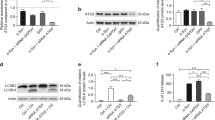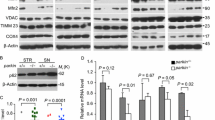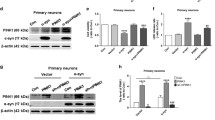Abstract
Mutations in Cu/Zn superoxide dismutase (SOD1) cause autosomal dominant amyotrophic lateral sclerosis (ALS), a devastating neurodegenerative disease with no effective treatment. Despite ample evidence indicating involvement of mutation-induced SOD1 protein misfolding and aggregation in ALS pathogenesis, the molecular mechanisms that control cellular management of misfolded, aggregation-prone SOD1 mutant proteins remain unclear. Here, we report that parkin, an E3 ubiquitin-protein ligase which is linked to Parkinson’s disease, is a novel regulator of cellular defense against toxicity induced by ALS-associated SOD1 mutant proteins. We find that parkin mediates K63-linked polyubiquitination of SOD1 mutants in cooperation with the UbcH13/Uev1a E2 enzyme and promotes degradation of these misfolded SOD1 proteins by the autophagy-lysosome system. In response to strong proteotoxic stress associated with proteasome impairment, parkin promotes sequestration of misfolded and aggregated SOD1 proteins to form perinuclear aggresomes, regulates positioning of lysosomes around misfolded SOD1 aggresomes, and facilitates aggresome clearance by autophagy. Our findings reveal parkin-mediated cytoprotective mechanisms against misfolded SOD1 toxicity and suggest that enhancing parkin-mediated cytoprotection may provide a novel therapeutic strategy for treating ALS.










Similar content being viewed by others
References
Andersen PM (2006) Amyotrophic lateral sclerosis associated with mutations in the CuZn superoxide dismutase gene. Curr Neurol Neurosci Rep 6(1):37–46
Rothstein JD (2009) Current hypotheses for the underlying biology of amyotrophic lateral sclerosis. Ann Neurol 65:S3-9. doi:10.1002/ana.21543
Wijesekera LC, Leigh PN (2009) Amyotrophic lateral sclerosis. Orphanet J Rare Dis 4:3. doi:10.1186/1750-1172-4-3
Rosen DR, Siddique T, Patterson D, Figlewicz DA, Sapp P, Hentati A, Donaldson D, Goto J et al (1993) Mutations in Cu/Zn superoxide dismutase gene are associated with familial amyotrophic lateral sclerosis. Nature 362(6415):59–62. doi:10.1038/362059a0
Gaudette M, Hirano M, Siddique T (2000) Current status of SOD1 mutations in familial amyotrophic lateral sclerosis. Amyotroph Lateral Scler Other Motor Neuron Disord 1(2):83–89
Galaleldeen A, Strange RW, Whitson LJ, Antonyuk SV, Narayana N, Taylor AB, Schuermann JP, Holloway SP et al (2009) Structural and biophysical properties of metal-free pathogenic SOD1 mutants A4V and G93A. Arch Biochem Biophys 492(1–2):40–47. doi:10.1016/j.abb.2009.09.020
Schmidlin T, Kennedy BK, Daggett V (2009) Structural changes to monomeric CuZn superoxide dismutase caused by the familial amyotrophic lateral sclerosis-associated mutation A4V. Biophys J 97(6):1709–1718. doi:10.1016/j.bpj.2009.06.043
Rakhit R, Crow JP, Lepock JR, Kondejewski LH, Cashman NR, Chakrabartty A (2004) Monomeric Cu, Zn-superoxide dismutase is a common misfolding intermediate in the oxidation models of sporadic and familial amyotrophic lateral sclerosis. J Biol Chem 279(15):15499–15504. doi:10.1074/jbc.M313295200
Hough MA, Grossmann JG, Antonyuk SV, Strange WR, Doucette PA, Rodriguez JA, Whitson LJ, Hart PJ et al (2004) Dimer destabilization in superoxide dismutase may result in disease-causing properties: structures of motor neuron disease mutants. Proc Natl Acad Sci U S A 101(16):5976–5981
Fischer LR, Culver DG, Tennant P, Davis AA, Wang M, Castellano-Sanchez A, Khan J, Polak MA et al (2004) Amyotrophic lateral sclerosis is a distal axonopathy: evidence in mice and man. Exp Neurol 185(2):232–240
Gerstner B, DeSilva TM, Genz K, Armstrong A, Brehmer F, Neve RL, Felderhoff-Mueser U, Volpe JJ et al (2008) Hyperoxia causes maturation-dependent cell death in the developing white matter. J Neurosci 28(5):1236–1245
Gruzman A, Wood WL, Alpert E, Prasad MD, Miller RG, Rothstein JD, Bowser R, Hamilton R et al (2007) Common molecular signature in SOD1 for both sporadic and familial amyotrophic lateral sclerosis. Proc Natl Acad Sci U S A 104(30):12524–12529. doi:10.1073/pnas.0705044104
Guareschi S, Cova E, Cereda C, Ceroni M, Donetti E, Bosco DA, Trotti D, Pasinelli P (2012) An over-oxidized form of superoxide dismutase found in sporadic amyotrophic lateral sclerosis with bulbar onset shares a toxic mechanism with mutant SOD1. Proc Natl Acad Sci U S A 109(13):5074–5079. doi:10.1073/pnas.1115402109
Choi J, Rees HD, Weintraub ST, Levey AI, Chin LS, Li L (2005) Oxidative modifications and aggregation of Cu,Zn-superoxide dismutase associated with Alzheimer and Parkinson diseases. J Biol Chem 280(12):11648–11655. doi:10.1074/jbc.M414327200
Ciechanover A (2005) Intracellular protein degradation: from a vague idea thru the lysosome and the ubiquitin-proteasome system and onto human diseases and drug targeting. Cell Death Differ 12(9):1178–1190. doi:10.1038/sj.cdd.4401692
Rubinsztein DC (2006) The roles of intracellular protein-degradation pathways in neurodegeneration. Nature 443(7113):780–786. doi:10.1038/nature05291
Niwa J, Ishigaki S, Hishikawa N, Yamamoto M, Doyu M, Murata S, Tanaka K, Taniguchi N et al (2002) Dorfin ubiquitylates mutant SOD1 and prevents mutant SOD1-mediated neurotoxicity. J Biol Chem 277(39):36793–36798. doi:10.1074/jbc.M206559200
Kabuta T, Suzuki Y, Wada K (2006) Degradation of amyotrophic lateral sclerosis-linked mutant Cu, Zn-superoxide dismutase proteins by macroautophagy and the proteasome. J Biol Chem 281(41):30524–30533
Tan JM, Wong ES, Kirkpatrick DS, Pletnikova O, Ko HS, Tay SP, Ho MW, Troncoso J et al (2008) Lysine 63-linked ubiquitination promotes the formation and autophagic clearance of protein inclusions associated with neurodegenerative diseases. Hum Mol Genet 17(3):431–439
Choi JS, Cho S, Park SG, Park BC, Lee DH (2004) Co-chaperone CHIP associates with mutant Cu/Zn-superoxide dismutase proteins linked to familial amyotrophic lateral sclerosis and promotes their degradation by proteasomes. Biochem Biophys Res Commun 321(3):574–583. doi:10.1016/j.bbrc.2004.07.010
Urushitani M, Kurisu J, Tateno M, Hatakeyama S, Nakayama K, Kato S, Takahashi R (2004) CHIP promotes proteasomal degradation of familial ALS-linked mutant SOD1 by ubiquitinating Hsp/Hsc70. J Neurochem 90(1):231–244. doi:10.1111/j.1471-4159.2004.02486.x
Crippa V, Carra S, Rusmini P, Sau D, Bolzoni E, Bendotti C, De Biasi S, Poletti A (2010) A role of small heat shock protein B8 (HspB8) in the autophagic removal of misfolded proteins responsible for neurodegenerative diseases. Autophagy 6(7):958–960. doi:10.4161/auto.6.7.13042
Crippa V, Sau D, Rusmini P, Boncoraglio A, Onesto E, Bolzoni E, Galbiati M, Fontana E et al (2010) The small heat shock protein B8 (HspB8) promotes autophagic removal of misfolded proteins involved in amyotrophic lateral sclerosis (ALS). Hum Mol Genet 19(17):3440–3456. doi:10.1093/hmg/ddq257
Sau D, De Biasi S, Vitellaro-Zuccarello L, Riso P, Guarnieri S, Porrini M, Simeoni S, Crippa V et al (2007) Mutation of SOD1 in ALS: a gain of a loss of function. Hum Mol Genet 16(13):1604–1618. doi:10.1093/hmg/ddm110
Bendotti C, Marino M, Cheroni C, Fontana E, Crippa V, Poletti A, De Biasi S (2012) Dysfunction of constitutive and inducible ubiquitin-proteasome system in amyotrophic lateral sclerosis: implication for protein aggregation and immune response. Prog Neurobiol 97(2):101–126. doi:10.1016/j.pneurobio.2011.10.001
Tashiro Y, Urushitani M, Inoue H, Koike M, Uchiyama Y, Komatsu M, Tanaka K, Yamazaki M et al (2012) Motor neuron-specific disruption of proteasomes, but not autophagy, replicates amyotrophic lateral sclerosis. J Biol Chem 287(51):42984–42994. doi:10.1074/jbc.M112.417600
Kopito RR (2000) Aggresomes, inclusion bodies and protein aggregation. Trends Cell Biol 10(12):524–530
Olzmann JA, Li L, Chin LS (2008) Aggresome formation and neurodegenerative diseases: therapeutic implications. Curr Med Chem 15(1):47–60
Iwata A, Christianson JC, Bucci M, Ellerby LM, Nukina N, Forno LS, Kopito RR (2005) Increased susceptibility of cytoplasmic over nuclear polyglutamine aggregates to autophagic degradation. Proc Natl Acad Sci U S A 102(37):13135–13140. doi:10.1073/pnas.0505801102
Olzmann JA, Chin LS (2008) Parkin-mediated K63-linked polyubiquitination: a signal for targeting misfolded proteins to the aggresome-autophagy pathway. Autophagy 4(1):85–87
Johnston JA, Dalton MJ, Gurney ME, Kopito RR (2000) Formation of high molecular weight complexes of mutant Cu, Zn-superoxide dismutase in a mouse model for familial amyotrophic lateral sclerosis. Proc Natl Acad Sci U S A 97(23):12571–12576
Wang H, Ying Z, Wang G (2012) Ataxin-3 regulates aggresome formation of copper-zinc superoxide dismutase (SOD1) by editing K63-linked polyubiquitin chains. J Biol Chem 287(34):28576–28585. doi:10.1074/jbc.M111.299990
Bruijn LI, Becher MW, Lee MK, Anderson KL, Jenkins NA, Copeland NG, Sisodia SS, Rothstein JD et al (1997) ALS-linked SOD1 mutant G85R mediates damage to astrocytes and promotes rapidly progressive disease with SOD1-containing inclusions. Neuron 18(2):327–338
Kitada T, Asakawa S, Hattori N, Matsumine H, Yamamura Y, Minoshima S, Yokochi M, Mizuno Y et al (1998) Mutations in the parkin gene cause autosomal recessive juvenile parkinsonism. Nature 392(6676):605–608. doi:10.1038/33416
Olzmann JA, Li L, Chudaev MV, Chen J, Perez FA, Palmiter RD, Chin LS (2007) Parkin-mediated K63-linked polyubiquitination targets misfolded DJ-1 to aggresomes via binding to HDAC6. J Cell Biol 178(6):1025–1038. doi:10.1083/jcb.200611128
Petrucelli L, O’Farrell C, Lockhart PJ, Baptista M, Kehoe K, Vink L, Choi P, Wolozin B et al (2002) Parkin protects against the toxicity associated with mutant alpha-synuclein: proteasome dysfunction selectively affects catecholaminergic neurons. Neuron 36(6):1007–1019
Rosen K, Moussa C, Lee H, Kumar P, Kitada T, Qin G, Fu Q, Querfurth H (2010) Parkin reverses intracellular beta-amyloid accumulation and its negative effects on proteasome function. J Neurosci Res 88(1):167–178
McKeon JE, Sha D, Li L, Chin L-S (2015) Parkin-mediated K63-polyubiquitination targets ubiquitin C-terminal hydrolase L1 for degradation by the autophagy-lysosome system. Cell Mol Life Sci 72(9):1811–1824
Perez FA, Palmiter RD (2005) Parkin-deficient mice are not a robust model of parkinsonism. Proc Natl Acad Sci U S A 102(6):2174–2179
Giles LM, Chen J, Li L, Chin L-S (2008) Dystonia-associated mutations cause premature degradation of torsinA protein and cell-type specific mislocalization to the nuclear envelope. Hum Mol Genet 17(17):2712–2722
Olzmann JA, Brown K, Wilkinson KD, Rees HD, Huai Q, Ke H, Levey AI, Li L et al (2004) Familial Parkinson’s disease-associated L166P mutation disrupts DJ-1 protein folding and function. J Biol Chem 279:8506–8515
Lee SM, Chin LS, Li L (2012) Charcot-Marie-Tooth disease-linked protein SIMPLE functions with the ESCRT machinery in endosomal trafficking. J Cell Biol 199(5):799–816. doi:10.1083/jcb.201204137
Pridgeon JW, Olzmann JA, Chin LS, Li L (2007) PINK1 protects against oxidative stress by phosphorylating mitochondrial chaperone TRAP1. PLoS Biol 5(7):e172. doi:10.1371/journal.pbio.0050172
Chin L-S, Nugent RD, Raynor MC, Vavalle JP, Li L (2000) SNIP, a novel SNAP-25-interacting protein implicated in regulated exocytosis. J Biol Chem 275:1191–1200
Chin LS, Vavalle JP, Li L (2002) Staring, a novel E3 ubiquitin-protein ligase that targets syntaxin 1 for degradation. J Biol Chem 277(38):35071–35079. doi:10.1074/jbc.M203300200
Kim BY, Olzmann JA, Barsh GS, Chin LS, Li L (2007) Spongiform neurodegeneration-associated E3 ligase Mahogunin ubiquitylates TSG101 and regulates endosomal trafficking. Mol Biol Cell 18(4):1129–1142. doi:10.1091/mbc.E06-09-0787
Gazdag EM, Cirstea IC, Breitling R, Lukes J, Blankenfeldt W, Alexandrov K (2010) Purification and crystallization of human Cu/Zn superoxide dismutase recombinantly produced in the protozoan Leishmania tarentolae. Acta Crystallogr Sect F Struct Biol Cryst Commun 66(Pt 8):871–877. doi:10.1107/S1744309110019330
Li Y, Chin LS, Weigel C, Li L (2001) Spring, a novel RING finger protein that regulates synaptic vesicle exocytosis. J Biol Chem 276(44):40824–40833. doi:10.1074/jbc.M106141200
Wheeler TC, Chin LS, Li Y, Roudabush FL, Li L (2002) Regulation of synaptophysin degradation by mammalian homologues of seven in absentia. J Biol Chem 277(12):10273–10282. doi:10.1074/jbc.M107857200
Fortun J, Dunn WA Jr, Joy S, Li J, Notterpek L (2003) Emerging role for autophagy in the removal of aggresomes in Schwann cells. J Neurosci 23:10672–10680
Wong ESP, Tan JMM, Soong W-E, Hussein K, Nukina N, Dawson VL, Dawson TM, Cuervo AM et al (2008) Autophagy-mediated clearance of aggresomes is not a universal phenomenon. Hum Mol Genet 17(16):2570–2582
Aquilano K, Rotilio G, Ciriolo MR (2003) Proteasome activation and nNOS down-regulation in neuroblastoma cells expressing a Cu, Zn superoxide dismutase mutant involved in familial ALS. J Neurochem 85(5):1324–1335
Kitamura A, Inada N, Kubota H, Matsumoto G, Kinjo M, Morimoto R, Nagata K (2014) Dysregulation of the proteasome increases the toxicity of ALS-linked mutant SOD1. Genes Cells 19(3):209–224
Joyce P, Mcgoldrick P, Saccon R, Weber W, Fratta P, West S, Zhu N, Carter S et al (2015) A novel SOD1-ALS mutation separates central and peripheral effects of mutant SOD1 toxicity. Hum Mol Genet 24:1883–1897
Rojas F, Cortes N, Abarzua S, Dyrda A, van Zundert B (2014) Astrocytes expressing mutant SOD1 and TDP43 trigger motoneuron death that is mediated via sodium channels and nitroxidative stress. Front Cell Neurosci 8 (24):doi:10.3389/fncel.2014.00024
Ghadge G, Pavlovic J, Koduvayur S, Kay B, Roos R (2013) Single chain variable fragment antibodies block aggregation and toxicity induced by familial ALS-linked mutant forms of SOD1. Neurobiol Dis 56:74–78
Anandhan A, Rodriguez-Rocha H, Bohovych I, Griggs AM, Zavala-Flores L, Reyes-Reyes EM, Seravalli J, Stanciu LA et al (2014) Overexpression of alpha-synuclein at non-toxic levels increases dopaminergic cell death induced by copper exposure via modulation of protein degradation pathways. Neurobiol Dis. doi:10.1016/j.nbd.2014.1011.1018
Borchelt DRGM, Wong PC, Lee MK, Slunt HS, Xu ZS, Sisodia SS, Price DL, Cleveland DW (1995) Superoxide dismutase 1 subunits with mutations linked to familial amyotrophic lateral sclerosis do not affect wild-type subunit function. J Biol Chem 270(7):3234–3238
Nakano RIT, Kikugawa K, Takahashi H, Sakimura K, Fujii J, Taniguchi N, Tsuji S (1996) Instability of mutant Cu/Zn superoxide dismutase (Ala4Thr) associated with familial amyotrophic lateral sclerosis. Neurosci Lett 211(2):129–131
Lee SM, Olzmann JA, Chin LS, Li L (2011) Mutations associated with Charcot-Marie-Tooth disease cause SIMPLE protein mislocalization and degradation by the proteasome and aggresome-autophagy pathways. J Cell Sci 124(Pt 19):3319–3331. doi:10.1242/jcs.087114
Korolchuk VI, Rubinsztein DC (2011) Regulation of autophagy by lysosomal positioning. Autophagy 7(8):927–928
Korolchuk VI, Saiki S, Lichtenberg M, Siddiqi FH, Roberts EA, Imarisio S, Jahreiss L, Sarkar S et al (2011) Lysosomal positioning coordinates cellular nutrient responses. Nat Cell Biol 13(4):453–460. doi:10.1038/ncb2204
Furukawa Y, O’Halloran TV (2005) Amyotrophic lateral sclerosis mutations have the greatest destabilizing effect on the apo- and reduced form of SOD1, leading to unfolding and oxidative aggregation. J Biol Chem 280(17):17266–17274. doi:10.1074/jbc.M500482200
Kirkin V, McEwan D, Novak I, Dikic I (2009) A role for ubiquitin in selective autophagy. Mol Cell 34(3):259–269
Chin LS, Olzmann JA, Li L (2010) Parkin-mediated ubiquitin signalling in aggresome formation and autophagy. Biochem Soc Trans 38(Pt 1):144–149
Lim GGY, Chew KCM, Ng X-H, Henry-Basil A, Sim RWX, Tan JMM, Chai C, Lim K-L (2013) Proteasome inhibition promotes Parkin-Ubc13 interaction and lysine 63-Linked Ubiquitination. PloS One 8(9):e73235
Johansen T, Lamark T (2011) Selective autophagy mediated by autophagic adapter proteins. Autophagy 7(3):279–296
Pankiv S, Clausen T, Lamark T, Brech A, Bruun J, Outzen H, Overvatn A, Bjorkoy G et al (2007) p62/SQSTM1 binds directly to Atg8/LC3 to facilitate degradation of ubiquitinated protein aggregates by autophagy. J Biol Chem 282(33):24131–24145
Zaarur N, Meriin AB, Bejarano E, Xu X, Gabai VL, Cuervo AM, Sherman MY (2014) Proteasome failure promotes positioning of lysosomes around the aggresome via local block of microtubule-dependent transport. Mol Cell Biol 34(7):1336–1348. doi:10.1128/MCB.00103-14
Acknowledgments
We thank Dr. Richard Palmiter for providing breeding pairs of parkin knockout mice and Drs. Haining Zhu and Do Hee Li for providing SOD1 plasmids. This work was supported by the National Institutes of Health (NIH) Grants to C.Y. (NS074620), L.L. (GM103613), L.S.C. (AG034126 and NS093550), and pilot grant awards from NIH-funded Emory Udall Parkinson’s Disease Center (P50 NS071669) and Emory University Research Committee to L.S.C. (SK38167) and L.L. (SK46673). C.Y. was a trainee supported by NIH Pharmacological Sciences Training Grant (T32 GM008602).
Author information
Authors and Affiliations
Corresponding author
Ethics declarations
Conflict of Interest
The authors declare that they have no conflict of interest.
Rights and permissions
About this article
Cite this article
Yung, C., Sha, D., Li, L. et al. Parkin Protects Against Misfolded SOD1 Toxicity by Promoting Its Aggresome Formation and Autophagic Clearance. Mol Neurobiol 53, 6270–6287 (2016). https://doi.org/10.1007/s12035-015-9537-z
Received:
Accepted:
Published:
Issue Date:
DOI: https://doi.org/10.1007/s12035-015-9537-z




